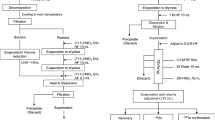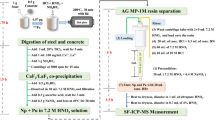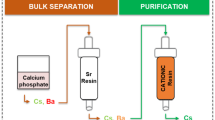Abstract
A new HCl-free chromatographic separation procedure has been developed for sequential separation of Zr and Mo from concrete matrices for selective measurement of 93Zr and 93Mo by ICP-MS/MS. The recoveries of greater than 90% for Zr and Mo from concretes could be achieved. The measurement condition was optimized for complete suppression of interferences from 93Nb and peak tailing from abundant isotopes of Zr and Mo in concrete matrices. The removal of interferences was verified by measurement of radio-contamination-free concretes used as a sample matrix blank. Method detection limits of 1.7 mBq g− 1 and 0.2 Bq g− 1 were achieved for, respectively, 93Zr and 93Mo in the concrete matrices. The interference removal factor for Nb (equivalent to the decontamination factor in radiochemical separation) was of the order of 105, and the abundance sensitivity was of the order of 10─8, indicating that the developed method is reliable for verifying the presence of ultralow concentrations of 93Zr and 93Mo. The present method is suitable for the rapid assessment of 93Zr and 93Mo for radioactivity inventory of concrete rubble.





Similar content being viewed by others
References
Japan Ministry of Economy, Trade and Industry, METI. Storage conditions of the rubble and tree. Available at: http://www.meti.go.jp/earthquake/nuclear/decommissioning/committee/osensuitaisakuteam/2017/07/3-04-02.pdf. In Japanese. Accessed on April 2020.
Hou X (2007) Radiochemical analysis of radionuclides difficult to measure for waste characterization in decommissioning of nuclear facilities. J Radioanal Nucl Chem 273:43–48
Tanaka K, Yasuda M, Watanabe K, Hoshi A, Katayama A, Higuchi H, Kameo Y (2013) Review and application of analytical flow to accumulated water generated at Fukushima Daiichi NPS. KEK Proc 2013–17:17–26
Shimada K, Iwasaki M, Kurosawa K, Hamada Y, Yonekawa M, Sato S, Kaji N, Koyama T, Nakayama S (2017) Application of ICP-MS to analytical methods for samples from 1F site at Okuma Analysis and Research Center. In: The 6th Asia-Pacific Symposium on Radiochemistry, Korea
Tanaka K, Shimada A, Hoshi A, Yasuda M, Ozawa M, Kameo Y (2014) Radiochemical analysis of rubble and trees collected from Fukushima Daiichi Nuclear Power Station. J Nucl Sci Technol 51(7,8):1032–1043
Erdtmann G, Soyka W (1975) The gamma-ray lines of radionuclides, ordered by atomic and mass number. Part II. Z = 58–100 (Cerium-Fermium). J Radioanal Chem 27:137–286
Espartero AG, Suarez JA, Rodrıgez M, Pina G (2002) Radiochemical analysis of 93Zr. Appl Radiat Isot 56:41–46
Oliveira TC, Monteiro RPG, Oliveira AH (2011) A selective separation method for 93Zr in radiochemical analysis of low and intermediate level wastes from nuclear power plants. J Radioanal Nucl Chem 289:497–501
Oliveira TC, Monteiro RPG, Kastner GF, Bessueille-Barbier F, Oliveira AH (2014) Radiochemical methodologies applied to determination of zirconium isotopes in low-level waste samples from nuclear power plants. J Radioanal Nucl Chem 302(1):41–47
Lehto J, Hou X (2011) Chemistry and analysis of radionuclides: laboratory techniques and methodology. Wiley–VCH, Weinheim
Shimada A, Ohmori H, Kameo Y (2017) Development of determination method of 93Mo content in metal waste generated at the Japan Power Demonstration Reactor. J Radioanal Nucl Chem 314:1361–1365
Osváth S, Vajda N, Molnár Z et al (2010) Determination of 237Np, 93Zr and other long-lived radionuclides in medium and low-level radioactive waste samples. J Radioanal Nucl Chem 286:675–680
Osváth S, Vajda N, Stefánka Z et al (2011) Determination of 93Zr and 237Np in nuclear power plant wastes. J Radioanal Nucl Chem 287:459–463
Alfonso MC, Bennett ME, Folden CM (2016) Extraction chromatography of the Rf homologs, Zr and Hf, using TEVA and UTEVA resins in HCl, HNO3, and H2SO4 media. J Radioanal Nucl Chem 307:1529–1536
Osváth S, Vajda N, Molnár Z et al (2017) Determination of 93Zr in nuclear power plant wastes. J Radioanal Nucl Chem 314:31–38
Remenec B, Dulanská S, Mátel Ľ. et al ( (2014) Development of a method for the determination of 93Zr and 94Nb in radioactive waste using TEVA® resin. J Radioanal Nucl Chem 302:117–122
Shimada A, Kameo Y (2016) Development of an extraction chromatography method for the analysis of 93Zr, 94Nb, and 93Mo in radioactive contaminated water generated at the Fukushima Daiichi Nuclear Power Station. J Radioanal Nucl Chem 310:1317–1323
Dulanská S, Remenec B, Gardoňová V et al (2012) Determination of 93Zr in radioactive waste using ion exchange techniques. J Radioanal Nucl Chem 293:635–640
Lu W, Anderson T et al (2015) Zr/Nb isobar separation experiment for future 93Zr AMS measurement. Nucl Instrum Meth B 361:491–495
Asai S, Hanzawa Y, Konda M, Suzuki D, Magara M, Kimura T, Ishihara R, Saito K, Yamada S, Hirota H (2018) Rapid separation of zirconium using microvolume anion-exchange cartridge for 93Zr determination with isotope dilution ICP-MS. Talanta 185(1):98–105
Shimada A, Ozawa M, Yabuki K, Kimiyama K, Sato K, Kameo Y (2014) Development of a separation method for molybdenum from zirconium, niobium, and major elements of rubble samples. J Chromatogr A 1371:163–167
Osváth S, Qiao J, Hou X (2019) Preparation of 93Mo solution using proton irradiated Nb. J Radioanal Nucl Chem 322:1833–1839
Triskem, International, ZR resin product sheet, https://www.triskem-international.com/scripts/files/5c5864b3c2ced4.93092048/PS_ZR-Resin_EN_171218.pdf. Accessed April 2020
Zheng J, Tagami K, Homma-Takeda S, Bu W (2013) The key role of atomic spectrometry in radiation protection. J Anal At Spectrom 28:1676–1699
Croudace IW, Russell BC, Warwick PE (2017) Plasma source mass spectrometry for radioactive waste characterisation in support of nuclear decommissioning: a review. J Anal At Spectrom 32:494–526
Bu W, Ni Y, Steinhauser G, Zheng W, Zheng J, Furuta N (2018) The role of mass spectrometry in radioactive contamination assessment after the Fukushima nuclear accident. J Anal At Spectrom 33:519–546
Warwick PE, Russell BC, Croudace IW, Zacharauskas Z (2019) Evaluation of inductively coupled plasma tandem mass spectrometry for radionuclide assay in nuclear waste characterisation J. Anal At Spectrom 34:1810
Warwick PE, Russell BC, Croudace IW, Zacharauskas Z (2019) Evaluation of inductively coupled plasma tandem mass spectrometry for radionuclide assay in nuclear waste characterisation. J Anal At Spectrom 34:1810
Bolea-Fernandez E, Balcaen L, Resano M, Vanhaecke F (2017) Overcoming spectral overlap via inductively coupled plasma-tandem mass spectrometry (ICP-MS/MS): a tutorial review. J Anal At Spectrom 32:1660–1679
Shikamori Y, Nakano K, Sugiyama N, Kakuta S (2012) Agilent Application Note, https://www.agilent.com/cs/library/applications/5991-0321EN_AppNote_8800_I.pdf. Accessed 22 Apr 2020
Ohno T, Muramatsu Y, Shikamori Y, Toyama C, Okabe N, and Matsuzaki H (2013) Determination of ultratrace 129I in soil samples by Triple Quadrupole ICP-MS and its application to Fukushima soil samples. J. Anal. At. Spectrom. 28:1283–1287.
Ohno T, Muramatsu Y (2014) Determination of radioactive cesium isotope ratios by triple quadrupole ICP-MS and its application to rainwater following the Fukushima Daiichi nuclear power plant accident. J. Anal. Atomic Spectrom. 29(2):347–351.
Suzuki T, Yamamura T, Abe C et al (2018) Actinide molecular ion formation in collision/reaction cell of triple quadrupole ICP-MS/MS and its application to quantitative actinide analysis. Radioanal Nucl Chem 318:221–225
Qiao J, Xu Y (2018) Direct measurement of uranium in seawater by inductively coupled plasma mass spectrometry. Talanta 183:18–23
Tanimizu M, Sugiyama MN, Ponzevera NE, Bayon EG G (2013) Determination of ultra-low 236U/238U isotope ratios by tandem quadrupole ICP-MS/MS. J Anal At Spectrom 28:1372–1376
Silva DF et al (2020) A new method for determining 236U/238U isotope ratios in environmental samples by means of ICP-MS/MS. Talanta 206:120221
Xing S, Zhang W, Qiao J, Hou X (2018) Determination of ultra-low level plutonium isotopes (239Pu, 240Pu) in environmental samples with high uranium. Talanta 187:357–364
Tiong LYD, Tan S (2019) In situ determination of 238Pu in the presence of uranium by triple quadrupole ICP-MS (ICP-QQQ-MS). J Radioanal Nucl Chem 322:399–406
Tiong LYD, Ho MLD, Pong BK et al (2017) A rapid method for quantifying 238Pu in the presence of natural 238U via quadrupole inductively coupled plasma mass spectrometry (ICP-MS) and utilizing a resin-based extraction procedure. J Radioanal Nucl Chem 314:1347–1351
Amr MA, Helal AFI, Al-Kinani AT, Balakrishnan P (2016) Ultra-trace determination of 90Sr, 137Cs, 238Pu, 239Pu, and 240Pu by triple quadruple collision/reaction cell-ICP-MS/MS: Establishing a baseline for global fallout in Qatar soil and sediments. J Environ Radioactiv 153:73–87
Tomita J, Takeuchi E (2019) Rapid analytical method of 90Sr in urine sample: Rapid separation of Sr by phosphate co-precipitation and extraction chromatography, followed by determination by triple quadrupole inductively coupled plasma mass spectrometry (ICP-MS/MS). Appl Radiat Isotopes 150:103–109
Ohno T, Hirono M, Kakuta S, Sakata S (2018) Determination of strontium 90 in environmental samples by triple quadrupole ICP-MS and its application to Fukushima soil samples. J Anal At Spectrom 33:1081–1085
Petrov P, Russell B, Douglas DN, Goenaga-Infante H (2018) Interference-free determination of sub ng kg– 1 levels of long-lived 93Zr in the presence of high concentrations (µg kg– 1) of 93Mo and 93Nb using ICP-MS/MS. Anal Bioanal Chem 410(3):1029–1037
Warwick FE, Russell BC, Croudace IW, Zacharauskas Z (2019) Evaluation of inductively coupled plasma tandem mass spectrometry for radionuclide assay in nuclear waste characterisation. J Anal At Spectrom 34:1810–1821
Gaudry A, Delmas R (2007) Multielement analysis of concrete from nuclear reactors by INAA, ICP-MS and ICP-AES. J Radioanal Nucl Chem 271:159–164
McCurdy E, Woods G, Sugiyama N (2019) Method development with ICP-MS/MS: tools and techniques to ensure accurate results in reaction mode. Spectrosc Spec Issue 34(9):20–27
Jones DMR (2007) A study of ion-molecule reactions in a dynamic reaction cell to improve elemental analysis with inductively coupled plasma-mass spectrometry. PhD Dissertation. The Ohio State University (Ohio United states), 583.
Japan Nuclear Safety Commission (2007) Radioactivity concentration upper limit for the disposal of low-level radioactive solid waste. (in Japanese) https://www.rwmc.or.jp/law/file/shiryo_14.pdf. AccessedApril 2020.
Acknowledgements
The present study is carried out under the research program based on subsidy to the International Research Institute for Nuclear Decommissioning (IRID) by Ministry of Economy, Trade and Industry, Japan.
Author information
Authors and Affiliations
Corresponding author
Ethics declarations
Conflict of interest
The authors declare that they have no conflict of interest
Additional information
Publisher's Note
Springer Nature remains neutral with regard to jurisdictional claims in published maps and institutional affiliations.
Electronic supplementary material
Below is the link to the electronic supplementary material.
Rights and permissions
About this article
Cite this article
Do, VK., Furuse, T., Murakami, E. et al. Development of HCl-free solid-phase extraction combined with ICP-MS/MS for rapid assessment of difficult-to-measure radionuclides. Part I: Selective measurement of 93Zr and 93Mo in concrete rubble. J Radioanal Nucl Chem 327, 543–553 (2021). https://doi.org/10.1007/s10967-020-07503-z
Received:
Accepted:
Published:
Issue Date:
DOI: https://doi.org/10.1007/s10967-020-07503-z




